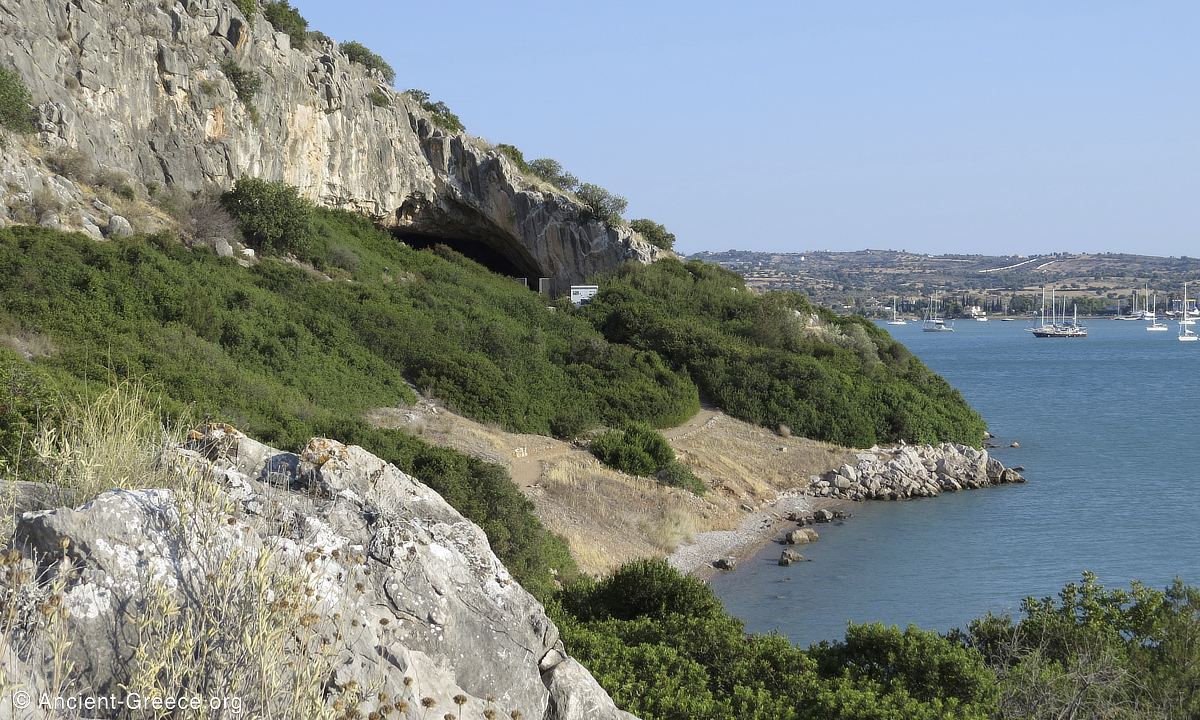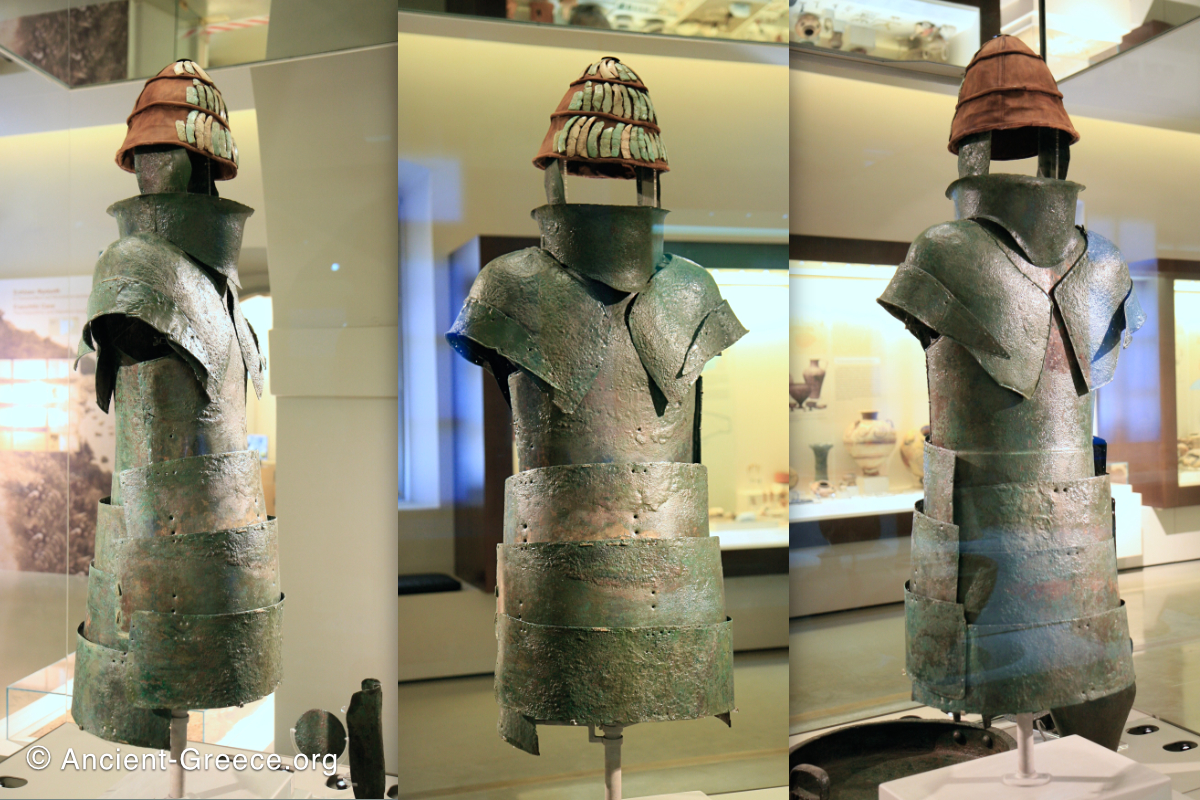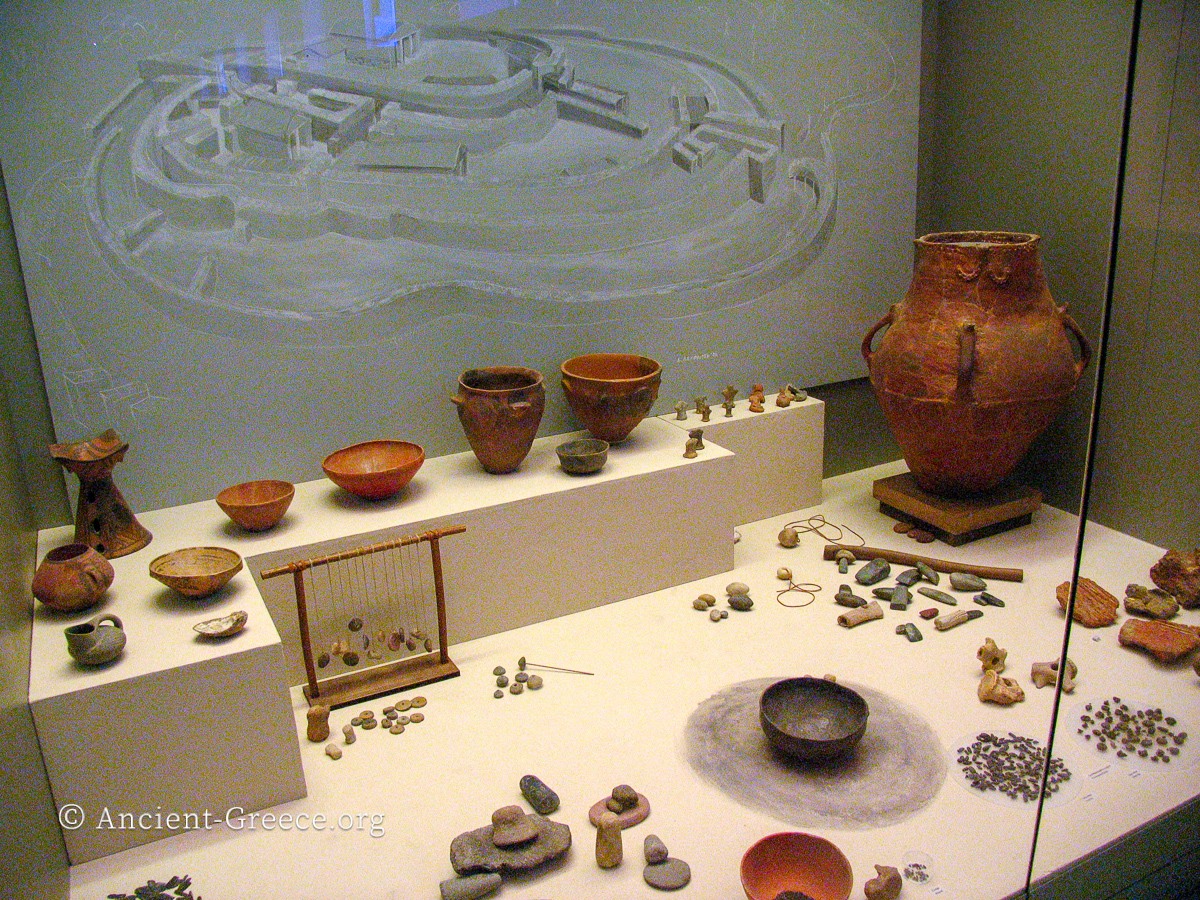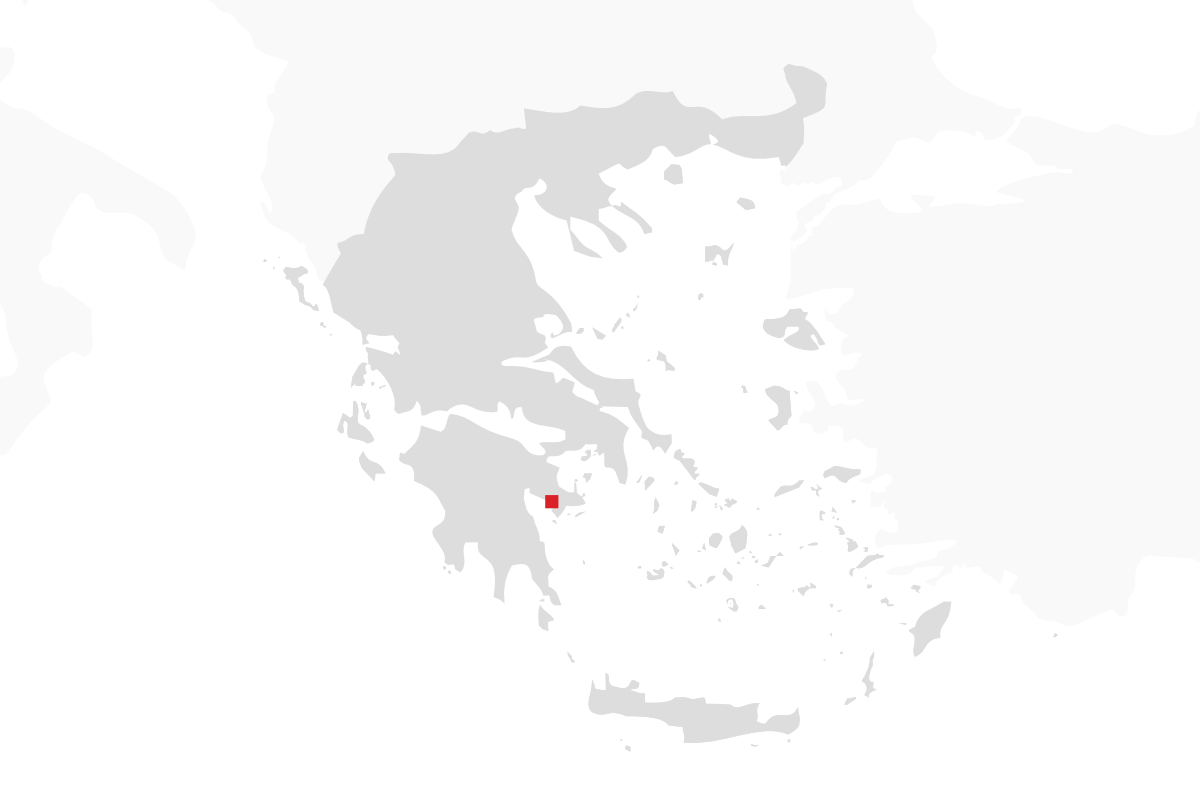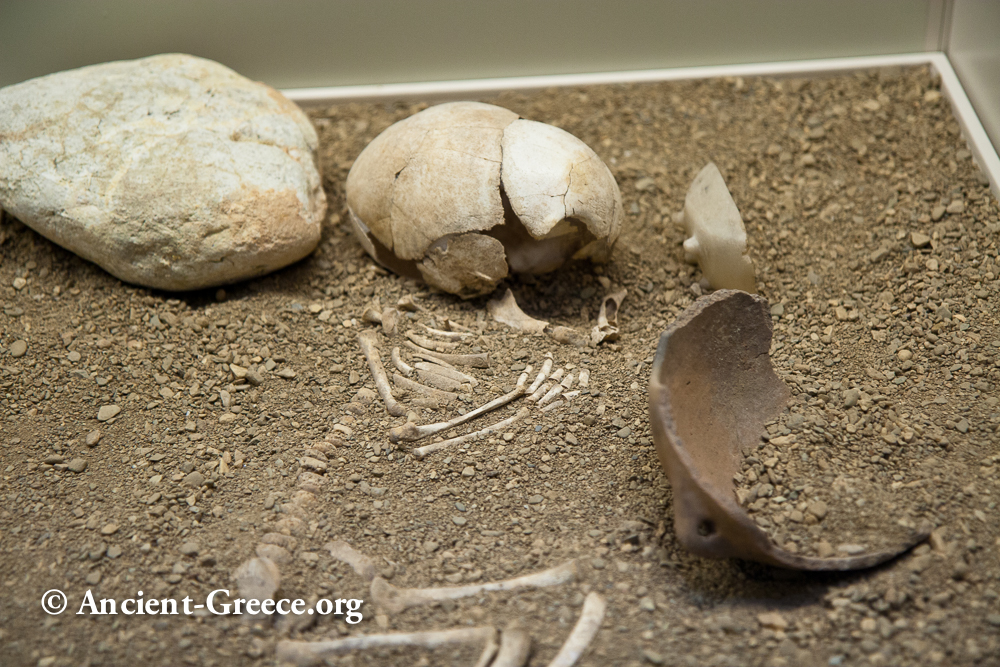
On this page:
Franchthi Cave (Φράγχθι Σπήλαιον) in Argolis, Peloponnese, Greece offers a rich unbroken record of human habitation from the Paleolithic era (at least since 38000 BCE) to the end of the Neolithic period and beyond.
Location
Francthi Cave is located at the end of a limestone headland on the northern side of Koiladha Bay, in Argolis, Peloponnese, Greece.
Throughout most of its inhabited history, Franchthi Cave was much farther from today’s seashore. Rising waters over a period of a few thousands years drowned the seven-kilometer valley that existed between the cave and the shore until at least the beginning of the Mesolithic period.
The remnants of the Neolithic village located on the shore just outside the cave was occupied from around 7000 BCE until the start of the Bronze Age.
According to the information posted on the archaeological site, “excavations carried out between 1967 and 1979 identified Upper Palaeolithic (40,000-10,00 years B.C.), Mesolithic (9,000-7,000 years B.C.) and Neolithic (7,000-3,000 years B.C.) occupation.”
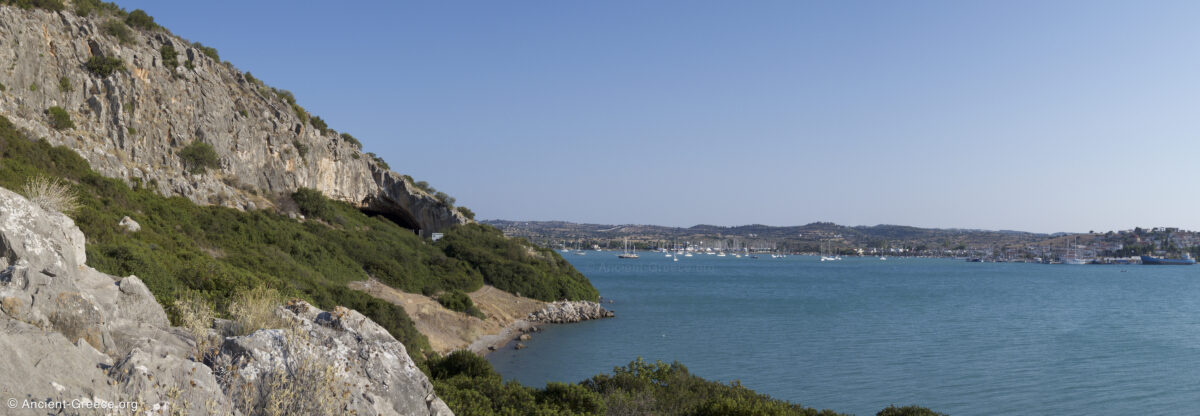
Paleolithic Era (40000 – 10000 BCE)
Palaeolithic groups were highly mobile and lived off the land by hunting, fishing and gathering plant resources.

During the Paleolithic Era, Franchthi cave was only occasionally occupied by hunters who left behind remnants of flint arrowheads and bones of larges animals (wild ass, bison, aurochs, elk species, red deer, horses, wild boar, goat and bovids), but no remnants of plant food or other evidence of permanent habitation such as graves, space alteration, or art.
Smaller animals were also part of the diet, including hare, hedgehog, turtles, tortoises and birds. Toward the end of the era seafood and land snail consumption increased.
Mesolithic Era (9000 – 7000 BCE)
Mesolithic groups continued to be highly mobile, living off the land by hunting, fishing and gathering plant resources.
The large number of graves, the child population, and imported goods found in excavations attest that the cave was continuously occupied by large groups during the Mesolithic Era.
Occupants of Franchthi cave during this period hunted and ate forest animals similar to the Paleolithic people, and for the first time we see evidence of wild plant consumption (wild barley, lentils, and nuts such as pistachios and almonds), along with seafood–some of deep sea origin (pelagic). According to Susan E. Allen from the Department of Anthropology, University of Cincinnati, Cincinnati, USA, “The identification of einkorn in impressions on ceramic sherds from the Franchthi Paralia pushes back the appearance of einkorn at Franchthi from the Middle Neolithic”.
This period yielded a rich record of artifacts ranging from stone tools and arrowheads, lava querns (imported from nearby volcanic islands), bones of forest animal, and the first evidence in Greece of human burials in a number of grades found in the cave’s mouth: “the most interesting of which was that of a young man about 29 years of age. He lay on his back with his legs folded up behind him and his hands over his chest. He was laid out on a bed of crushed shell and ash with a mound of stones heaped over his body, He died of a blow to the head, but the condition of his bones shows that he was suffering from anemia, perhaps the result of malaria, when he died, approximately 9,500 years ago.
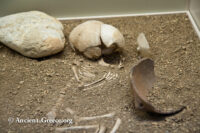
The other graves, some of which are interments and others cremations, are of men, women, and children, evidence that whole families resided in the cave with enough permanence to protect their deceased relatives from scavengers and disturbance by natural agents.”. (Runnels & Murray, 36)
Fish bones point to the consumption of inshore species such as sea bream, along with barracuda, mullets, sea bass, conger eel, marine mollusks (limpets, turbans, clams and cockles), as well as more open water pelagic species such as tuna.
Cyclope and Columbella shells were used as ornaments, while those of Murex suggest their use as bait. Land snails were also collected especially during the final phases of the Upper Paleolithic and the Mesolithic.
Stone Age Seafaring People
The remnants of deep sea fish and the existence of a large quantity of obsidian tools which shown through chemical analysis to have been imported form the island of Melos, 90 nautical miles of open sea away, are strong indications that the cave inhabitants and their contemporaries must have used boats.
Although, no vessel has survived some speculate that they were light boats made of reed similar to Papyrella boats used until recently on Corfu island.
Could obsidian source be on the mainland? There is another volcano within walking distance from Franchthi, but it produces Andesite / Balsatic Andesite, and Dacite lava, not “felsic”, like the Melos volcano which yields obsidian. Information on the topic is scant, though most geology publications indicate that Methana volcano does not produce obsidian. Information is also scant on whether plate tectonics could play a role in obsidian relocating from Melos to the mainland over millions of years. So, Stone Age seafaring is the most common explanation for the appearance of obsidian tools in the cave.
Read more about ships in Ancient Greece…
Neolithic era (7000 – 3000 BCE)
In the Neolithic period, occupants engaged in farming and animal husbandry, and new tools related to faming appeared (sickle blades, millstones, etc.).
The settlement grew out of the cave to form the now-submerged village.
Information posted on Franchthi cave indicates: “In addition to the practices and implements used for animal husbandry and the cultivation and processing of crops, other objects such as clay loom weights for weaving of cloth appeared during the Neolithic.
Hunting of wild animals and the collection of land snails and marine mollusks continued but to a lesser extent, while tuna fishing dropped off significantly.
Conversely though, the use of volcanic obsidian intensified during the Neolithic, reaching the cave as finished implements probably made by specialist craft people. Other specialised manufacture [included] the production of shell ornaments.
Appearance of Neolithic Pottery
Pottery was one of the primary innovations of the Neolithic, the result of long-term experimentation with the properties of clay and firing techniques. Clay pots at the site, some of which were carefully decorated, were all hand made and used in domestic contexts as well as for special occasions.
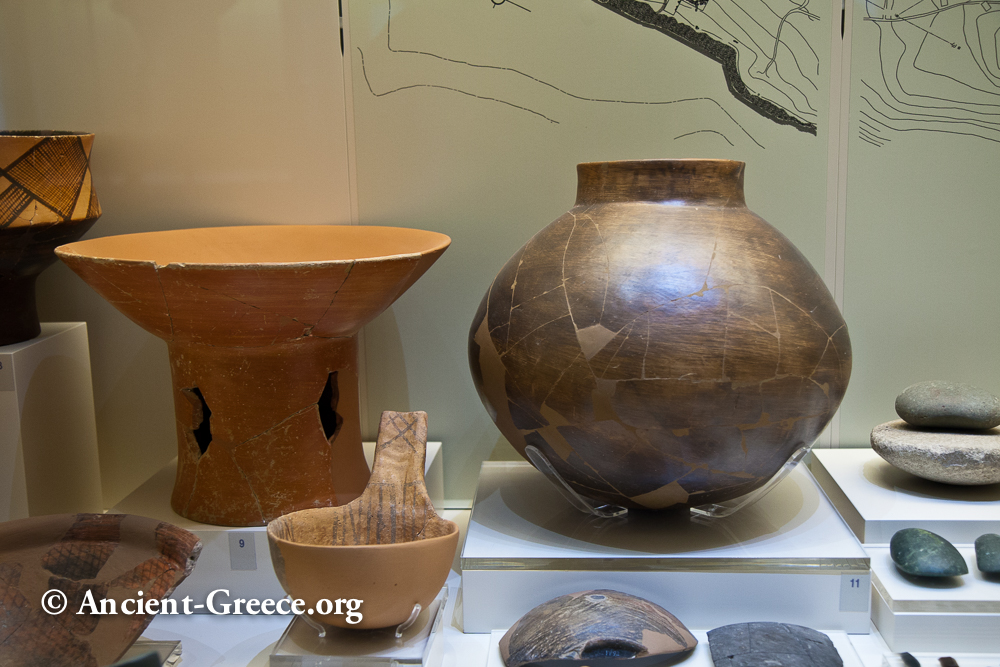
Directly related to pot making is the production of clay figurines. The latter refer to small sized anthromorphic, zoomorphic or object images whose use appears to be varied.
Some could have been used in daily tasks, but others could have been employed in magical or symbolic acts, as instructional or information broadcasting devices even as children’s toys.
Body details were shaped with lumps of clay, as well as wood, stones and other materials. More rarely, figurines could have been made of stone such as marble, ophiolite and others. Twenty four figurines were discovered at Franchthi, all but two were made of clay and just one of marble. They have been recovered mainly from the cave and less from Paralia.”.
Photos of Franchthi Cave Artifacts
Artifacts from the Franchthi cave excavations are on display in the Nafplion Archaeological Museum.
Excavations
“Excavations were carried out inside and outside of the cave between 1967 and 1979 under the directorship of T.W. Jacobsen of Indiana University (U.S.A) and the auspices of the American School of Classical Studies at Athens. […] they shed light on issues related to the transition from hunter-gatherer to farming societies, seafaring in the Aegean, mortuary practices in the Mesolithic and Neolithic, as well as clay pot making.” (Archaeological site posted information).
The archeological work in the cave broke new ground in methodologies. “The revolutionary adoption of a systematic and intensive sampling strategy for the recovery of plant remains at Franchthi Cave (Hansen 1991) marked a methodological paradigm shift in Aegean prehistoric archaeology. […] data expands the range of crops represented at the site during the Early Neolithic to include einkorn wheat (Triticum monococcum L.), pushing back its appearance at Franchthi by several centuries.”(Allen).









